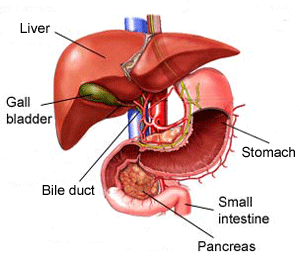Liver: Difference between revisions
No edit summary |
Cleaned up the format. Added in a lot of missing links. |
||
| (3 intermediate revisions by 3 users not shown) | |||
| Line 1: | Line 1: | ||
[[Image:Liver diagram.gif|frame|right|Liver diagram.gif]]The liver is a vital [[Organ|organ]] in all [[Vertebrates]] as well as some [[Invertebrates]] (e.g. octopuses and other cephalopods). It is both the largest solid organ and the largest gland within the human body, weighing ~1.8 kg in men and 1.3 kg in women <ref name="The British Liver Trust">http://www.britishlivertrust.org.uk/home/the-liver.aspx</ref>. It plays a vital role in [[Metabolism|metabolism]] and has a wide range of functions within the body, including [[Glycogen|glycogen]] storage, detoxification and [[Bile|bile]] production. | [[Image:Liver diagram.gif|frame|right|Liver diagram.gif]]The liver is a vital [[Organ|organ]] in all [[Vertebrates]] as well as some [[Invertebrates]] (e.g. octopuses and other cephalopods). It is both the largest solid organ and the largest gland within the human body, weighing ~1.8 kg in men and 1.3 kg in women <ref name="The British Liver Trust">http://www.britishlivertrust.org.uk/home/the-liver.aspx</ref>. It plays a vital role in [[Metabolism|metabolism]] and has a wide range of functions within the body, including [[Glycogen|glycogen]] storage, detoxification and [[Bile|bile]] production. | ||
<div> | <div> | ||
This organ has remarkable regenerative abilities which allows surgeons to perform liver transplants where the donor is still alive. The liver is approximately halved during the surgery and within 4-8 weeks it should have grown back to it's normal size<ref>http://www.transplant.bc.ca/pre_livingliver.htm</ref>. This ability also means that, in transplantations where the donor is deceased, there is a possibility that it can be given to two patients rather than the one.<br> | This organ has remarkable regenerative abilities which allows surgeons to perform liver transplants where the donor is still alive. The liver is approximately halved during the surgery and within 4-8 weeks it should have grown back to it's normal size <ref>http://www.transplant.bc.ca/pre_livingliver.htm</ref>. This ability also means that, in transplantations where the donor is deceased, there is a possibility that it can be given to two patients rather than the one.<br> | ||
== Anatomy == | == Anatomy == | ||
The liver is reddish brown in colour and is divided into two main lobes which are further seperated into thousands of smaller lobules. The majority of the liver is made up of hepatocytes which are involved in the [[Metabolism|metabolism]] of drugs, for example [[Paracetamol|paracetamol]] via the [[CYTp450|CYTp450]] enzyme. | The liver is reddish brown in colour and is divided into two main lobes which are further seperated into thousands of smaller lobules. The majority of the liver is made up of [[Hepatocytes|hepatocytes]] which are involved in the [[Metabolism|metabolism]] of drugs, for example [[Paracetamol|paracetamol]] via the [[CYTp450|CYTp450]] enzyme. It's main blood supply is the hepatic artery. | ||
= The Main Functions of the liver<ref>Boyle M (2008) Biology | == The Main Functions of the liver<ref>Boyle M. (2008) Biology, 3rd edition, London: Collins. p242</ref> == | ||
Control of blood glucose levels Detoxification | *Control of [[Blood glucose levels|blood glucose levels]] | ||
*Detoxification | |||
*Control of [[amino acids|amino acid]] levels | |||
*Production of [[bile|bile]] | |||
*Synthesis of plasma proteins | |||
*Control of [[lipid|lipid]] levels | |||
*Synethesis of [[fetal red blood cells|fetal red blood cells]] | |||
*Storage of [[vitamins|vitamins]] | |||
*Destruction of [[red blood cells|red blood cells]] | |||
*[[Cholesterol|Cholesterol]] formation<br> | |||
The hepatic portal vein brings amino acids to the liver where they are [[Deamination|deaminated]] or [[Transamination|transaminated]], used to synethesise [[Plasma proteins|plasma proteins]] such as [[Fibrinogen|fibrinogen]] or can be released unchanged for other cells in the body to use for protein synthesis. | |||
== References == | |||
<references /><br><br></div> | |||
<references /><br><br> | |||
Latest revision as of 13:49, 21 October 2016

The liver is a vital organ in all Vertebrates as well as some Invertebrates (e.g. octopuses and other cephalopods). It is both the largest solid organ and the largest gland within the human body, weighing ~1.8 kg in men and 1.3 kg in women [1]. It plays a vital role in metabolism and has a wide range of functions within the body, including glycogen storage, detoxification and bile production.
This organ has remarkable regenerative abilities which allows surgeons to perform liver transplants where the donor is still alive. The liver is approximately halved during the surgery and within 4-8 weeks it should have grown back to it's normal size [2]. This ability also means that, in transplantations where the donor is deceased, there is a possibility that it can be given to two patients rather than the one.
Anatomy
The liver is reddish brown in colour and is divided into two main lobes which are further seperated into thousands of smaller lobules. The majority of the liver is made up of hepatocytes which are involved in the metabolism of drugs, for example paracetamol via the CYTp450 enzyme. It's main blood supply is the hepatic artery.
The Main Functions of the liver[3]
- Control of blood glucose levels
- Detoxification
- Control of amino acid levels
- Production of bile
- Synthesis of plasma proteins
- Control of lipid levels
- Synethesis of fetal red blood cells
- Storage of vitamins
- Destruction of red blood cells
- Cholesterol formation
The hepatic portal vein brings amino acids to the liver where they are deaminated or transaminated, used to synethesise plasma proteins such as fibrinogen or can be released unchanged for other cells in the body to use for protein synthesis.
References
- ↑ http://www.britishlivertrust.org.uk/home/the-liver.aspx
- ↑ http://www.transplant.bc.ca/pre_livingliver.htm
- ↑ Boyle M. (2008) Biology, 3rd edition, London: Collins. p242